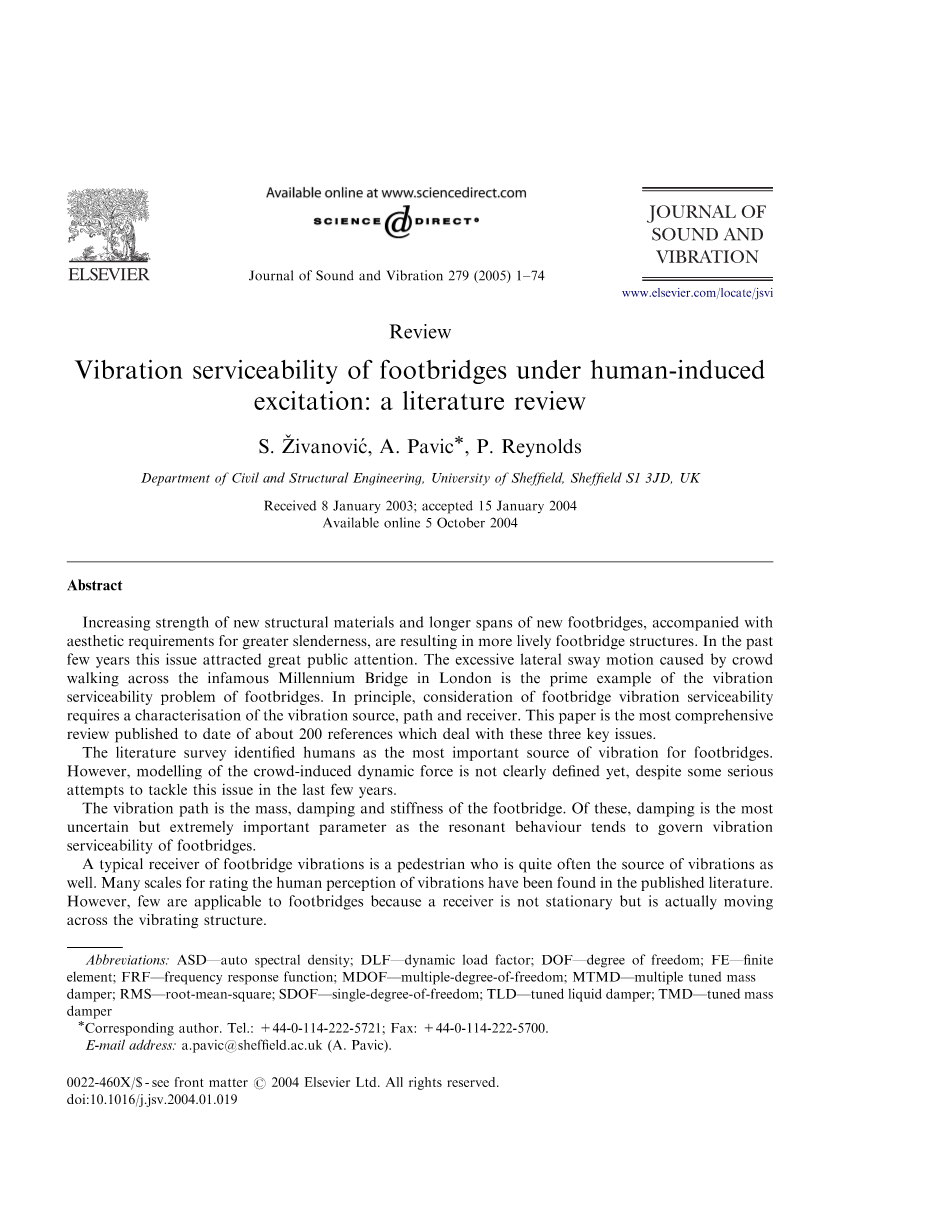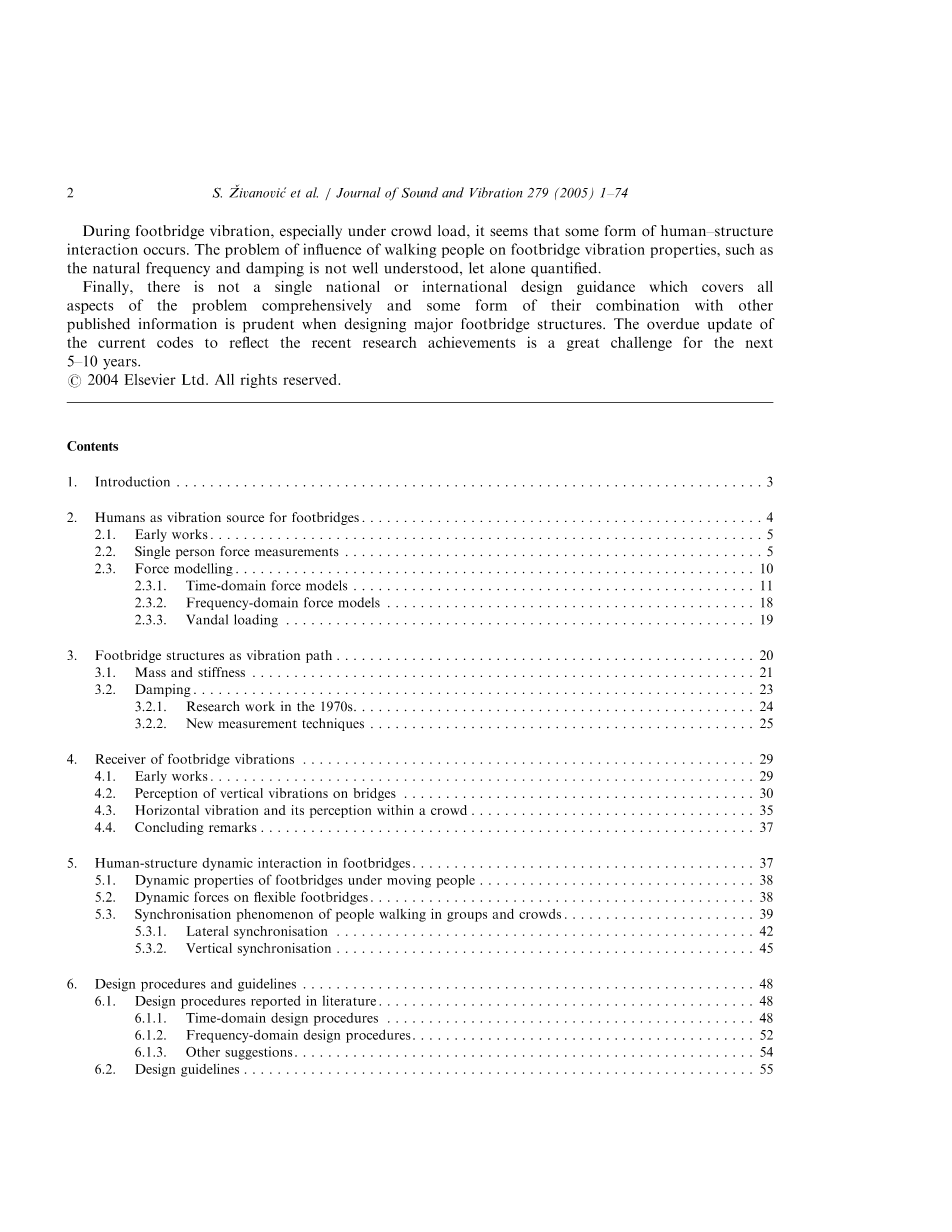多通道登机桥的动力响应分析外文翻译资料
2022-09-23 16:53:43


英语原文共 74 页,剩余内容已隐藏,支付完成后下载完整资料
|
Vibration serviceability of footbridges under human-induced excitation: a literature review |
人为刺激下的人行桥振动可靠度 ——文献综述 |
|
Abstract Increasing strength of new structural materials and longer spans of new footbridges, accompanied with aesthetic requirements for greater slenderness, are resulting in more lively footbridge structures. In the past few years this issue attracted great public attention. The excessive lateral sway motion caused by crowd walking across the infamous Millennium Bridge in London is the prime example of the vibration serviceability problem of footbridges. In principle, consideration of footbridge vibration serviceability requires a characterisation of the vibration source, path and receiver. This paper is the most comprehensive review published to date of about 200 references which deal with these three key issues. The literature survey identified humans as the most important source of vibration for footbridges. However, modeling of the crowd-induced dynamic force is not clearly defined yet, despite some serious attempts to tackle this issue in the last few years. The vibration path is the mass, damping and stiffness of the footbridge. Of these, damping is the most uncertain but extremely important parameter as the resonant behavior tends to govern vibration serviceability of footbridges. A typical receiver of footbridge vibrations is a pedestrian who is quite often the source of vibrations as well. Many scales for rating the human perception of vibrations have been found in the published literature. However, few are applicable to footbridges because a receiver is not stationary but is actually moving across the vibrating structure. During footbridge vibration, especially under crowd load, it seems that some form of human–structure interaction occurs. The problem of influence of walking people on footbridge vibration properties, such as the natural frequency and damping is not well understood, let alone quantified. Finally, there is not a single national or international design guidance which covers all aspects of the problem comprehensively and some form of their combination with other published information is prudent when designing major footbridge structures. The overdue update of the current codes to reflect the recent research achievements is a great challenge for the next 5–10 years. Introduction In recent decades there has been a trend towards improved mechanical characteristics of materials used in footbridge construction. It has enabled engineers to design lighter, more slender and more aesthetic structures. A considerable variety of modern footbridge structural forms can be seen, for example, in recent articles by Biliszczuk et al., Block and Schlaich, Eyre, Firth, Iso and Masubuchi, Mimram, Schlaich, Strasky, Takenouchi and Ito and Wouml;rner and Schlaich. As a result of these construction trends, many footbridges have become more susceptible to vibrations when subjected to dynamic loads. This paper is focused on human-induced dynamic loading of footbridges. This is a frequently occurring and often dominant load for footbridges as it stems from the very purpose of a footbridge—to convey pedestrians. It was noted very early that this type of dynamic excitation could cause excessive vibrations and in extreme cases even a collapse of the structure. It is known that in 1154 a timber footbridge collapsed under a crowd that wanted to greet the Archbishop William. However, details related to the exact crowd behaviour are not known. Probably the oldest case of footbridge failure due to dynamic human-induced load reported in detail was the one which occurred in 1831 in Broughton, UK while 60 soldiers were marching across a bridge. It was this event that prompted the placement of the famous notices on a considerable number of bridges with a warning to troops to break step when crossing. One of the notices displayed on a railway suspension bridge at Niagara Falls, USA reads as follows: A fine of $50 to $100 will be imposed for marching over this bridge in rank and file or to music, or by keeping regular step. Bodies of men or troops must be kept out of step when passing over this bridge. No musical band will be allowed to play while crossing except when seated in wagons or carriages. Although there have been many reported cases of lively footbridges in the past, this problem attracted considerably greater public and professional attention after the infamous swaying of the new and attractive Millennium Bridge in London during its opening day on 10 June 2000. The Millennium Bridge problem attracted more than 1000 press articles and over 150 broadcasts in the media around the world. In this and almost all other previously reported problems related to footbridge vibrations, the excessive vibrations were caused by a near resonance of one or more modes of vibration. The reason for this is that the range of footbridge natural (vertical or lateral) frequencies often coincides with the dominant frequencies of the human-induced load. It is important to note that the problems have occurred on a range of different structural types, such as cable-stayed, suspension and girder bridges, as well as on footbridges made of different materials (e.g. timber, composite steel-concrete, steel, reinforced and prestressed concrete). The problem of footbridge vibrations is becoming so alarming that a major international conference, entitled Footbridge 2002, was recently held in Paris and was almost completely devoted to this issue. Among many articles given at the conference, three presented the current state-of-the-art in footbridge vibration serviceability design, especially with regard to human-induced dynamic load. Nowadays, it is generally accepted that vibra 剩余内容已隐藏,支付完成后下载完整资料 资料编号:[148101],资料为PDF文档或Word文档,PDF文档可免费转换为Word |




